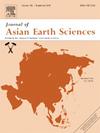Relocation of major earthquakes in India from 1905 to 2011 using a non-linear probabilistic approach
IF 2.7
3区 地球科学
Q2 GEOSCIENCES, MULTIDISCIPLINARY
引用次数: 0
Abstract
We perform probabilistic hypocentral location inversion for 10 major earthquakes in India that occurred since the dawn of the seismological instrumental era in 1904. A non-linear inversion approach with an efficient global sampling algorithm is used to obtain an estimate of the probability density function (PDF) in 3D space for the hypocenter estimation. The objective function that is minimized is an equal-differential traveltime formulation, that quantifies the difference between the observed and synthetic traveltimes for a pair of stations. Significant improvement in hypocentral location is obtained for five earthquakes in our dataset that occurred before the installation of the WWSSN network. The improvement and standardization of the global seismometer network in the 1960s led to more accurate and consistent location estimates across multiple reporting agencies. For post-1960 events, our hypocenter estimates are consistent with those reported by other authors. In most cases our maximum likelihood location lies in the vicinity of a mapped active fault, thereby providing confidence in our solution. The improvement in location estimate is gauged by measuring traveltime residuals across all stations and the size of the error ellipsoid.

用非线性概率方法重新定位1905 - 2011年印度大地震
本文对印度自1904年地震仪器时代开始以来发生的10次大地震进行了概率震源定位反演。采用非线性反演方法和高效的全局采样算法,在三维空间中获得震源估计的概率密度函数(PDF)。最小化的目标函数是一个等微分旅行时间公式,它量化了一对站点的观测和合成旅行时间之间的差异。在我们的数据集中,在安装WWSSN网络之前发生的5次地震的震源位置得到了显著改善。20世纪60年代全球地震仪网络的改进和标准化使得多个报告机构之间的位置估计更加准确和一致。对于1960年以后的事件,我们的震源估计与其他作者报告的一致。在大多数情况下,我们的最大似然位置位于绘制的活动断层附近,从而为我们的解决方案提供了信心。通过测量所有站点的旅行时残差和误差椭球的大小来衡量位置估计的改进。
本文章由计算机程序翻译,如有差异,请以英文原文为准。
求助全文
约1分钟内获得全文
求助全文
来源期刊

Journal of Asian Earth Sciences
地学-地球科学综合
CiteScore
5.90
自引率
10.00%
发文量
324
审稿时长
71 days
期刊介绍:
Journal of Asian Earth Sciences has an open access mirror journal Journal of Asian Earth Sciences: X, sharing the same aims and scope, editorial team, submission system and rigorous peer review.
The Journal of Asian Earth Sciences is an international interdisciplinary journal devoted to all aspects of research related to the solid Earth Sciences of Asia. The Journal publishes high quality, peer-reviewed scientific papers on the regional geology, tectonics, geochemistry and geophysics of Asia. It will be devoted primarily to research papers but short communications relating to new developments of broad interest, reviews and book reviews will also be included. Papers must have international appeal and should present work of more than local significance.
The scope includes deep processes of the Asian continent and its adjacent oceans; seismology and earthquakes; orogeny, magmatism, metamorphism and volcanism; growth, deformation and destruction of the Asian crust; crust-mantle interaction; evolution of life (early life, biostratigraphy, biogeography and mass-extinction); fluids, fluxes and reservoirs of mineral and energy resources; surface processes (weathering, erosion, transport and deposition of sediments) and resulting geomorphology; and the response of the Earth to global climate change as viewed within the Asian continent and surrounding oceans.
 求助内容:
求助内容: 应助结果提醒方式:
应助结果提醒方式:


